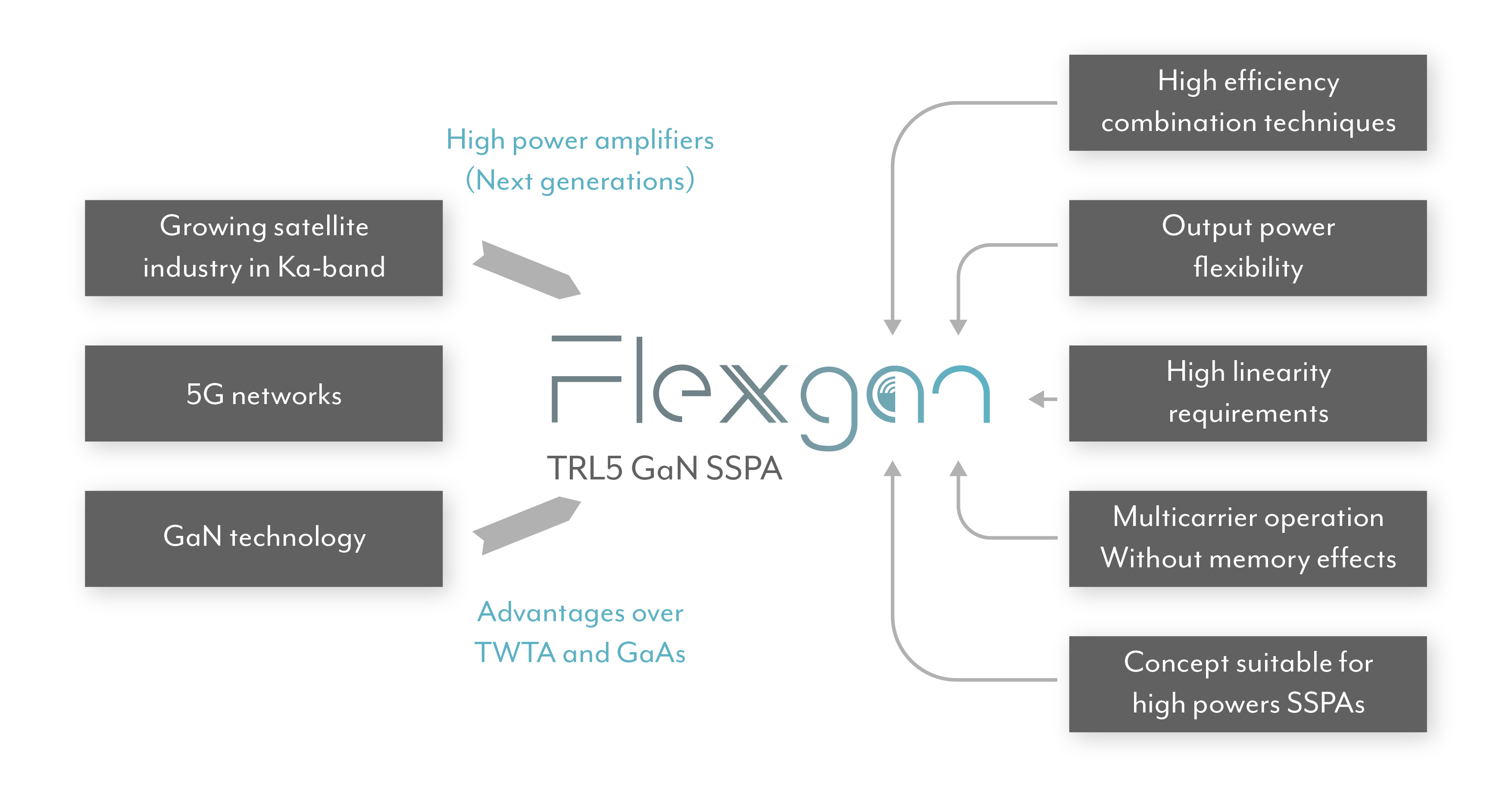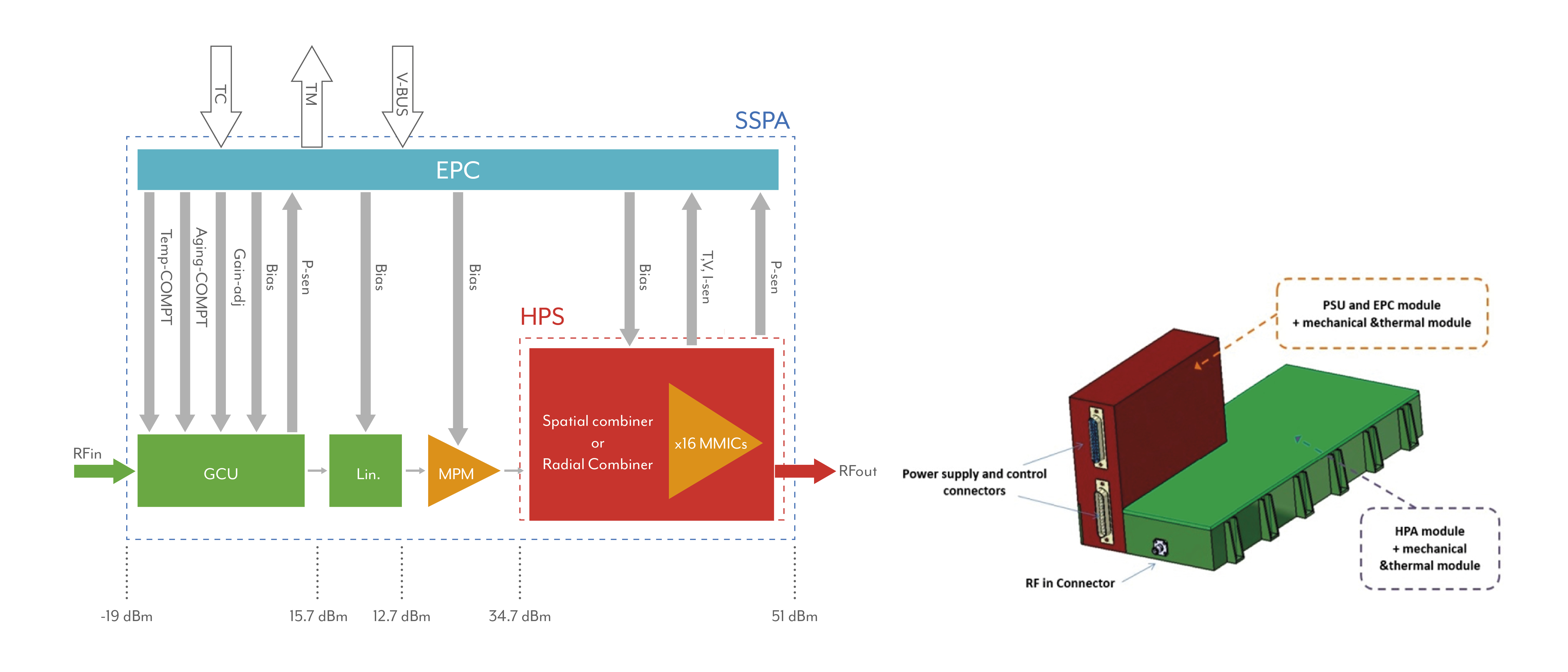5G demand requires the deployment of very High Throughput Satellites (vHTS) than can satisfy the expected needs implying a growth opportunity for GEO satellites. This kind of spacecraft offers high capacity, large number of users and communication volumes (1 Terabit/s per satellite), with lower cost per GBPS, increasing the flexibility since the satellite capacity is allocated where it is needed. Future vHTS satellites will make use of Ka/Q/V gateways where the forward payload link will operate in K-band. Traditionally, demand for power at high frequencies has resulted in Travelling Wave Tube Amplifiers (TWTAs) as the logical amplifier of choice; this is due to the fact that traditional Solid State Power Amplifier (SSPA) technology was unavailable at similar performance levels. However, technological advancements such as linearization, miniaturisation, and the use of different materials such as Gallium Nitride (GaN), have levelled the playing field for SSPAs.
FLEXGAN project aims to design, develop and test, in a representative space environment (TRL5), a low cost high power and efficient Ka-band GaN SSPA with RF output power varying capability, with high innovative & low loss recombination schemes and able to operate in multicarrier operation mode for on-board 5G satellite applications. The operational frequency band is 17.3-20.2 GHz and the objective output power is 125 W CW. The main innovations that FLEXGAN brings are: 1) Bring known terrestrial technologies by TTI to space; 2) SSPA able to provide the required output power maximising the power added efficiency to compensate the downlink fading losses; 3) SSPA able to transmit in multicarrier mode w/o memory effect; 4) Implementation of highly innovative linearization techniques; 5) use of lightweight composite structures to decrease the weight of the overall SSPA. Furthermore, in order to have a 100% European SSPA a Monolithic Microwave Integrated Circuit (MMIC) based on D01GH technology from OMMIC will be designed, manufactured and tested.
Why GaN technology in space?
Radio-frequency (RF) power amplifiers (PAs) are one of the key components on-board of communication satellites and consume the 80–90% of the spacecraft bus power. Therefore, amplifier Direct Current (DC) to RF power conversion efficiency is of utmost importance. Travelling Wave Tube Amplifiers (TWTAs) and solid state power amplifiers (SSPAs) are the two main amplifier choices for space-based RF communication. Traditionally, demand for power at high frequencies has resulted in TWTAs as the logical amplifier of choice; this is due to the fact that traditional SSPA technology was unavailable at similar performance levels. However, technological advancements such as linearization, miniaturisation, and the use of different materials such as GaN, have levelled the playing field for SSPAs.
The main advantages of GaN-based SSPAs are: a) Lower hardware cost; b) More reliability because they work a lower DC voltages; c) The own development nature in terms of redundancy because SSPAs are formed by means of the combination of several MMICs (graceful degradation); d) Enhanced flexibility; e) Does not need a heating time providing an instantaneous initiation; f) Very small group delay variations versus temperature and frequency.
It is clear that high efficiency GaN SSPAs can replace TWTAs in high power and high frequency payload applications but for that, the technology at MMIC level has to be able to provide the required RF power in Ka band with the efficiency that the system needs. Actually, in Europe the OMMIC D01GH GaN/Si process is the most suitable process for power applications up to Ka band. Furthermore, in space applications the size and weight are also limited resources which directly affect the satellite launch cost.
The impact of GaN technology in space-borne units is now a priority concern due to the different applications in which it can be used. There are some initiatives to develop GaN MMICs and low power GaN based HPAs. However, it has not identified any project or development in Ka-band for the development of high power GaN based SSPAs due to the challenge in the design of the efficient combination of several GaN devices at Ka-band frequencies whereas the size and weight is kept as low as possible.
Why FLEXGAN project?
There are several important efforts in Europe focused on demonstrating the capabilities of GaN technology applied to HPA for space segment. Despite of the promising results, there is still some uncertainty in the aerospace market to introduce a new technology by replacement of another (TWTAs) that has demonstrated its validity during years. FLEXGAN will allow reinforcing and corroborating the use of GaN technology for space applications.
FLEXGAN Consortium members have a wide experience in the design of Ka-band GaN based SSPAs for satellite communications in the ground segment. However, a scenario for space hardware is quite different and more challenging from ground hardware. Some of the critical challenges are: the on-board DC power generation, the thermal management, the multipaction and corona effects due to vacuum operation, the ionizing radiations, the availability of space qualified component, the reliability guidelines, etc. Therefore, this project will bring known terrestrial technologies to space.

The concept
The proposed architecture for the development of the flexible Ka-Band SSPA is shown in the following figure. It is composed by mainly 2 structures: the low frequency unit, namely the Electronic Power Conditioner (EPC), and the RF Tray (RFT) based on GaN technology.

The former has the aim to properly interface the SSPA with the satellite external bus, thus providing the DC bias voltages to the SSPA internal devices, to implement the Telemetry/Telecomand (TC/TM) services as well as the remote control through the CAN bus, to monitor the SSPA behaviour in terms of gain, power delivered, temperature in GaN devices, etc., and to properly set the internal parameters (i.e., the control voltage signals) of the SSPA to implement either Fixed Gain Mode (FGM) or Automatic Control Level (ACL) operating conditions, as well as to properly compensate for both thermal and component aging variations.
The RF Tray unit, i.e., the transmitting chain (Tx), is developed to properly amplify the input multicarrier signal up to the required output power level, while assuring high linearity and efficiency performances. The RFT, and more in details the last section, namely HPS in the above figure, represents the most challenging aspect of this proposal. For its development, the work is conducted following two main actions in parallel: the first one is related to the development of very high efficiency and linear MMIC power amplifiers based on GaN technology, which will become the brick for the realization of the HPS; the second one is to combine 16 of these elementary MMIC with maximum efficiency in order to properly attain the required very large amount of output power (125 W), thus to serve as TWTA replacement in vHTS or HTS satellites. For the combination, two main technologies are investigated: spatial and radial power combining techniques.
Furthermore, FLEXGAN project will consist in the combination of materials and processes to improve the performance of composite materials in order to use them in the construction of the SSPA mechanical and thermal parts.







